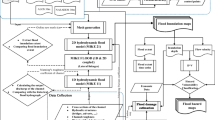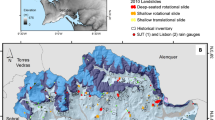Abstract
Landslide risk assessments provide essential information to develop loss reduction strategies. However, only very few studies produce risk maps. Lack of temporal data on landslides is one of the reasons. This paper develops a methodology to assess the economic risk of landslides when limited landslide hazard information is available. It provides spatially explicit estimates of future landslide risks in a densely populated low-relief area and applies different spatial probability scenarios. In the study area (710 km2), residential buildings cover 7 % of the area with elements at risk, but are responsible for about 86 % of the total risk. Roads cover 8 % of the area with elements at risk but are responsible for about 14 % of the total risk. The annual landslide risk is approximately 50 million to 80 million euros 2011 values depending on the spatial probability scenario considered. This indicates that landslide mitigation efforts would create considerable benefits. Landslide risk would reduce significantly if better land use zoning would be applied to sterilize landslide-prone terrain as particularly the residential buildings and access roads determine the total risk.







Similar content being viewed by others
References
Cardinali M, Reichenbach P, Guzetti F, Ardizzone F, Antonini G, Galli M, Cacciano M, Castellani M, Salvati P (2002) A geomorphological approach to the estimation of landslide hazards and risks in Umbria, Central Italy. Nat Hazards Earth Syst Sci 2:57–72
Carrara A, Cardinali M, Guzzetti F, Reichenback P (1995) GIS technology in mapping landslide hazard. In: Carrara A, Guzzetti F (eds) Geographical information systems in assessing natural hazards. Kluwer Acad. Publ, Dordrecht, pp 135–176
Crozier MJ (1986) Landslides: causes, consequences & environment. Croom Helm, Dover
Dai FC, Lee CF, Ngai YY (2002) Landslide risk assessment and management: an overview. Eng Geol 64:65–87
De Vos W (1997) Influence of the granitic batholith of Flanders on Acadian and later deformation (Brabant Massif, Belgium). Aardkundige Mededelingen 8:49–52
Dombrecht M, Heremans D, Plasschaert S, Vanneste J (2005) Geld en financiewezen. België in het Eurogebied. Vijfde editie. De Boeck nv. Antwerpen
EOS (2009) White Paper. A global European approach for energy infrastructure protection and resilience, pp. 31
EWCII, ONU, ISDR (2003) Europe, Regional consultation in preparation for the second International conference on early warning (EWCII), E. J. Plate, ISDR - International strategy for disaster reduction
Fell R, Corominas J, Bonnard C, Cascini L, Leroi E, Savage WZ (2008) Guidelines for landslide susceptibility, hazard and risk zoning for land-use planning. Eng Geol 102:99–111
Fuchs S, Heiss K, Hübl J (2007) Towards an empirical vulnerability function for use in debris flow risk assessment. Nat Hazards Earth Syst Sci 7:495–506
Ghosh S, van Westen CJ, Carranza EJM, Jetten VG (2012) Integrating spatial, temporal and magnitude probabilities for medium-scale landslide risk analysis in Darjeeling Himalayas, India. Landslides 9(3):371–384
Gibson AD, Culshaw MG, Dashwood C, Pennington CVL (2012) Landslide management in the UK—the problem of managing hazards in a ‘low-risk’ environment. Landslides 10:599–610
Glade T (1998) Establishing the frequency and magnitude of landslide-triggering rainstorm events in New Zealand. Environ Geol 35(2–3):160–174
Glade T, Crozier MJ (2005) The nature of landslide hazard impact. In: Glade T, Anderson MG, Crozier MJ (eds) Landslide hazard and risk. John Wiley, Chichester, pp 43–74
Guzzetti F, Carrara A, Cardinali M, Reichenbach P (1999) Landslide hazard evaluation: a review of current techniques and their application in a multi-scale study, Central Italy. Geomorphology 31:181–216
Holcombe E, Smith S, Wright E, Anderson MG (2012) An integrated approach for evaluating the effectiveness of landslide risk reduction in unplanned communities in the Caribbean. Nat Hazards 61:351–385
Jacobs P, DeCeukelaire M, DeBreuck W, DeMoor G (1999) Toelichting bijde geologische kaart van België: Vlaams gewest, kaartblad 29Kortrijk, schaal 1/50000. Ministerie van Economische zaken en Ministerie van de Vlaamse Gemeenschap, Brussel.
Lee EM, Jones DKC (2004) Landslide risk assessment. Thomas Telford, London, p 454
Li C, Ma T, Sun L, Li W, Zheng A (2012) Application and verification of a fractal approach to landslide susceptibility mapping. Nat Hazards 61:169–185
Mendelsohn R, Saher G (2010) “The global impact of climate change on extreme events.” Background paper for the WB/UN report “Natural hazards, unnatural Disasters”
OECD (2003) Emerging systemic risks in the 21st century. An agenda for action. OECD publishing, Paris, France, p 290
Ost L, Van Den Eeckhaut M, Poesen J, Vanmaercke-Gottigny M (2003) Characteristics and spatial distribution of large landslides in the Flemish Ardennes (Belgium). Z Geomorphol 47(3):329–350
Papathoma M, Dominey-Howes D (2003) Tsunami vulnerability assessment and its implications for coastal hazard analysis and disaster management planning, Gulf of Corinth, Greece. Nat Hazards Earth Syst Sci 3:733–747
Papathoma-Köhle M, Neuhauser B, Ratzinger K, Wenzel H, Dominey Howes D (2007) Elements at risk as a framework for assessing the vulnerability of communities to landslides. Nat Hazards Earth Syst Sci 7:765–779
Pellicani R, van Westen C, Spilotro G (2014) Assessing landslide exposure in areas with limited landslide information, Landslides, published online February 2013
Petrucci O, Gulla G (2010) A simplified method for assessing landslide damage indices. Nat Hazards 52(3):539–560
Petrucci O, Polemio M, Pasqua AA (2008) Analysis of damaging hydrogeological Events: The case of the Calabria Region (Southern Italy). Environ Manag 43(3):483–495
Proost S, Rousseau S (2007) Inleiding tot de milieueconomie. Acco, Leuven
Puissant A, Van Den Eeckhaut M, Malet J-P, Maquaire O (2014) Landslide consequence analysis: a region-scale indicator-based methodology. Landslides, published online September 2013
Remondo J, Bonachea J, Cendrero A (2005) A statistical approach to landslide risk modelling at basin scale: from landslide susceptibility to quantitative risk assessment. Landslides 2:321–328
Rossi M, Guzzetti F, Reichenbach P, Mondini AC, Peruccacci S (2010) Optimal landslide susceptibility zonation based on multiple forecasts. Geomorphology 114:129–142
Spiker EC, Gori PL (2003) National landslide hazards mitigation strategy: a framework for loss reduction, Department of Interior, USGS, Open-file Report 00–450, 49 pp
Van Den Eeckhaut M, Poesen J (2009) Uitbreiding (fase 3) van de gevoeligheidskaart voor grondverschuivingen in Vlaanderen, Rapport in opdracht van Vlaamse Overheid, Departement Leefmilieu, Natuur en Energie, Afdeling Land en Bodembescherming. Ondergrond, Natuurlijke Rijkdommen, Brussel
Van Den Eeckhaut M, Poesen J, Verstraeten G, Govers G (2005) Verkennende studie met betrekking tot massabewegingen in de Vlaamse Ardennen. Deel I: Studiegebied, literatuurstudie, inventarisatie en classificatie (+steekkaarten), statistische en ruimtelijke analyse en methodologie voor het ontwerp van een risicokaart. Rapport in Opdracht van de Vlaamse Gemeenschap, AMINAL, Afdeling Land, Brussel
Van Den Eeckhaut M, Vanwalleghem T, Poesen J, Govers G, Verstraeten G, Vandekerckhove L (2006) Prediction of landslide susceptibility using rare events logistic regression: a case-study in the Flemish Ardennes (Belgium). Geomorphology 76:392–410
Van Den Eeckhaut M, Poesen J, Verstraeten G (2007a) Vervolgproject – Opstellen van een gevoeligheidskaart met betrekking tot grondverschuivingen voor de Vlaamse Ardennen. Rapport in opdracht van Vlaamse Overheid, Departement Leefmilieu, Natuur en Energie, Afdeling Land en Bodembescherming, Ondergrond, Natuurlijke Rijkdommen, Brussel
Van Den Eeckhaut M, Poesen J, Dewitte O, Demoulin A, De Bo H, Vanmaercke-Gottigny MC (2007b) Reactivation of old landslides: lessons learned from a case-study in the Flemish Ardennes (Belgium). Soil Use Manag 23:200–211
Van Den Eeckhaut M, Muys B, Van Loy K, Poesen J, Beeckman H (2009) Evidence for repeated re-activation of old landslides under forest. Earth Surf Process Landf 34:352–365
Van Den Eeckhaut M, Poesen J, Vandekerckhove L, Van Gils M, Van Rompaey A (2010) Human-environment interactions in residential areas susceptible to landsliding: the Flemish Ardennes case-study. Area 42(3):339–358
Van Turnhout P, Vranken L, Van Den Eeckhaut M, Poesen J (2012) Inventarisatie van ernstige schade door grondverschuivingen, oorzaken en remediërende maatregelen in zuidelijk Oost- en West-Vlaanderen en Vlaams-Brabant. Rapport in opdracht van Vlaamse Overheid, Departement Leefmilieu, Natuur en Energie, Afdeling Land en Bodembescherming, Ondergrond, Natuurlijke Rijkdommen. 2012; pp. 200
van Westen CJ, van Asch TWJ, Soeters R (2006) Landslide hazard and risk zonation—why is it still so difficult? Bull Eng Geol Environ 65(2):167–184
Vanacker V, Vanderschraeghe M, Govers G, Willems E, Poesen J, Deckers J, De Bievre B (2003) Linking hydrological, infinite slope stability and land-use change models through GIS for assessing the impact of deforestation on slope stability in high Andes watersheds. Geomorphology 52:299–315
Vranken L, Van Turnhout P, Van Den Eeckhaut M, Vandekerckhove L, Poesen J (2013) Economic valuation of landslide damage in hilly regions: a case study from Flanders, Belgium. Sci Total Environ 447:323–336
World Bank, United Nations (2010) Natural hazards, unnatural disasters. The economics of effective prevention. World Ban, Washington
Zêzere JL, Garcia RAC, Oliveira SC, Reis E (2008) Probabilistic landslide risk analysis considering direct costs in the area north of Lisbon (Portugal). Geomorphology 94(3–4):467–495
Author information
Authors and Affiliations
Corresponding author
Rights and permissions
About this article
Cite this article
Vranken, L., Vantilt, G., Van Den Eeckhaut, M. et al. Landslide risk assessment in a densely populated hilly area. Landslides 12, 787–798 (2015). https://doi.org/10.1007/s10346-014-0506-9
Received:
Accepted:
Published:
Issue Date:
DOI: https://doi.org/10.1007/s10346-014-0506-9




